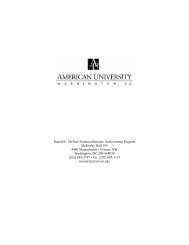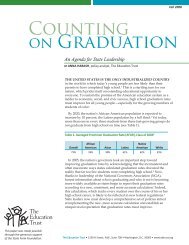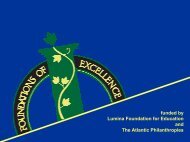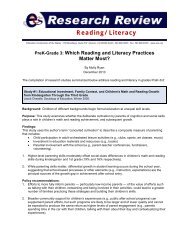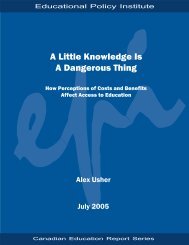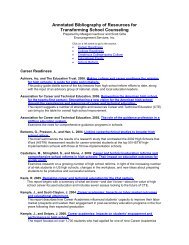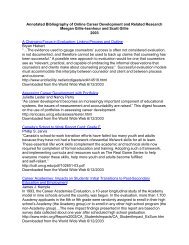Resistance Theory and the Transculturation Hypothesis
Resistance Theory and the Transculturation Hypothesis
Resistance Theory and the Transculturation Hypothesis
Create successful ePaper yourself
Turn your PDF publications into a flip-book with our unique Google optimized e-Paper software.
22The changes that corresponded with this phase of self-discovery were provocative.Students generally reported <strong>the</strong>y became more relaxed <strong>and</strong> comfortable in college.Moreover, this self-discovery allowed transculturated students <strong>the</strong> ability to move into<strong>the</strong> third stage of <strong>the</strong>ir educational, cultural process, that of realignment.Stage Three: RealignmentWith <strong>the</strong> strength <strong>and</strong> confidence that <strong>the</strong>y found in <strong>the</strong>ir cultural identity, transculturatedstudents began a realignment process. At this stage, students made necessary (<strong>and</strong>practical) adjustments in <strong>the</strong>ir personal, social, <strong>and</strong> academic worlds. They generallybegan to learn how to relate at both cultural levels as dem<strong>and</strong>ed by <strong>the</strong> situation.Fur<strong>the</strong>r, at this third stage students reassessed <strong>the</strong>mselves <strong>and</strong> <strong>the</strong>ir situation. As ageneral pattern <strong>the</strong>y evaluated <strong>the</strong>ir repertoire of values, attitudes, <strong>and</strong> goals <strong>and</strong>measured <strong>the</strong>m against those institutionalized in <strong>the</strong> higher educational system. They<strong>the</strong>n began to align <strong>the</strong>mselves with <strong>the</strong> nature of academia <strong>and</strong> used <strong>the</strong> appropriatenorms <strong>and</strong> behavior as needed. In short, most learned to cross cultural boundarieswhen necessary. At this stage, <strong>the</strong>y were well into <strong>the</strong> process of transculturation.A middle-aged woman from <strong>the</strong> Pine Ridge (South Dakota) reservation, by anyst<strong>and</strong>ards a culturally traditional American Indian person (whose late fa<strong>the</strong>r was a wellknown Lakota spiritual leader), described <strong>the</strong> realignment process this way:When we go to school we live a non-Indian way but we still keep our values . . . I couldput my Indian values aside just long enough to learn what it is I want to learn but thatdoesn’t mean I’m going to forget <strong>the</strong>m. I think that is how strong <strong>the</strong>y are with me.22




